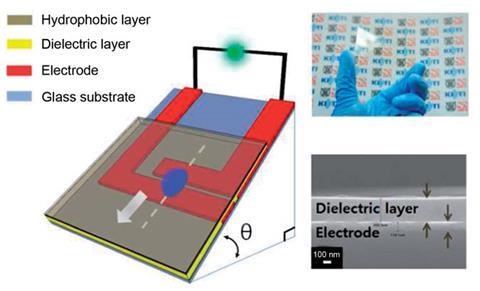Transducer converts water motion into energy

Researchers in South Korea have devised a way to harness the motion of water, including from raindrops or from a flushing toilet, as a sustainable energy source.
Devices that renewably generate electricity in an uncomplicated manner are in demand. Now, Youn Sang Kim and his team at Seoul National University and Korea Electronics Technology Institute (KETI) have adapted a transducer to convert the mechanical energy from water motion into electrical energy.
When dielectric materials are in water, an electrical double layer forms around the outside of the material. Variations between water and a poly (4 vinyl phenol) dielectric layer were shown to induce electric charges at an electrode. The team demonstrated that in such a system the motion from a 30µl water droplet generated enough electricity to power a green LED.
‘We hope our work can be applied to everyday life,’ says Kim. This is a realistic possibility as the electrodes are flexible and transparent so could coat windows, roofs and even toilet bowls, to generate electricity from raindrops and water flow.
‘The researchers have taken advantage of the contact electrification between a polymer and water droplets in motion to design a simple energy harvester,’ says Andreas Menzel, who develops semiconducting nanodevices at the University of Freiburg in Germany. ‘There is plenty of water motion like rain, sea waves or wastewater, in our environment where these kinds of power generators can find application.’
The team are working on determining the charging mechanism and the detailed operation of their water motion active transducer. Furthermore, they are hoping to enhance the output conversion power of the device.






No comments yet